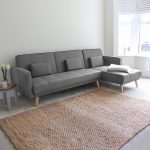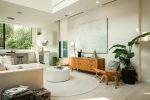Easy ways to create an open plan living space
Over the past few years, many people have started moving away from the traditional notions of how rooms should function. It used to be that houses had many different, smaller rooms, each of which was used for its own, specific purpose. However, more and more people are now starting to embrace the idea of open plan living – having a space that is larger, more open, and has multiple different uses. Creating an open plan home can seem daunting, but it doesn’t have to be! Below are some easy ways to create the open plan living space of your dreams and start making the most out of your home.
Use colour to tie your space together
Not all of us are blessed with a home that already has a large, open-plan space to utilise, and knocking down walls is not always an option! This can make it difficult to envisage how you might make your currently separate rooms into a place that feels more cohesive.
One easy way of creating a flowing, open space is to keep a consistent colour scheme throughout your rooms. You may have a separate living room and dining room, however by picking a colour scheme that is the same in both rooms, you can link the two different rooms in a way that makes them feel more connected. This doesn’t just apply to the paint on the walls, though. Think about furniture, accessories, and decorations and how they can be used to tie rooms together into a flowing whole.

Or use colour to differentiate areas
If you do have a multi-functional, open-plan space in your home, it can sometimes be hard to differentiate between areas and stop it from feeling like a big, empty train station. Using colour can help here in a different way. By choosing specific colour themes for specific uses, you can effectively separate your space without having to sacrifice the open design with walls or partitions.
Consider using block colours to create distinct feelings and areas. Think about how you want each area to feel and design accordingly – perhaps warm colours for a cosy living space to relax in at the end of the day, or bright, natural greens to inspire creativity in your workspace. The same can also be done with your furniture and accessories.
Different textures can also be used to great effect to delineate between spaces. Perhaps you have wood flooring but would like something warmer in your living room area – consider adding a rug. In your workspace, consider clean, minimal designs that will help keep your head clear, whereas in the family areas, perhaps give the walls some character with paintings and ornaments. This is your space, so think about what you want to use it for and how it will fit with your lifestyle.

Natural light will enhance space
A surefire way to make a room feel more open and spacious is to flood it with natural light. The more natural light you are able to get into your rooms, the larger they will feel. This will give your living area room to breathe and add to a feeling of openness. When paired with lighter colours, natural light can totally transform the feeling of your indoor spaces.
It can be difficult to increase the amount of natural light in a space, but one great way to do so is by installing bifold doors. Bifold doors provide an effective and stylish way of bringing the outdoors inside by replacing part of an existing wall with a chic set of glass doors. The benefits of this are twofold. Not only will the glass allow lots more natural light to flood into your space, making it feel more open and airy, the bifold doors can also be opened fully, allowing the inside to flow outdoors. This will add to the feeling of spaciousness in your indoor areas, as well as providing much more scope for you to move without being inhibited by walls and doors.
Make furniture work for you
Much like with a cohesive colour scheme, using furniture effectively can really help you to make the most out of your open plan living space. Think about how you arrange your furniture and how it can be used to link or cut off spaces while maintaining that open-plan feel. For example, an L-shaped sofa is a great choice for a seating area, as it provides a natural barrier that encloses part of your room without the need for walls or partitions. This allows you to create a snug living room, while still leaving the room free and open.
Consider using flexible furniture that can be moved or adjusted to accommodate different uses. Instead of a sofa, perhaps some comfortable chairs that can be arranged and rearranged as the need arises would work better. Perhaps your workspace can be transformed into a quiet reading area with a fold-away desk, or the dinner table can become a place for meetings and coffee mornings with the addition of some cushions and throws. The possibilities for your furniture are only limited by your creativity. Don’t work around your furniture, make it work for you.
Partial partitions can create a feeling of openness
Partial divides can allow you to have an open plan living space, without losing smaller rooms and areas within this. Partial divides that cut off one area from another without blocking them entirely can create the illusion that your separate rooms are one big space. Strategic use of furniture and colour schemes can help to link disparate areas together into a flowing space for you to enjoy.
Partial divides may also provide an option for those with blocking walls. It may be more feasible for you to have a section removed from a wall instead of the whole wall taken down in its entirety. It may also be a better option for you to just remove existing doors that stand between your rooms, tying the spaces together while still maintaining something of a barrier between them.
Whatever you decide to do, make your homework for you. An open plan living space doesn’t have to mean a vast, empty room that allows you to move from one side of the house to the other unimpeded. Instead, think about your family’s lifestyle and design it around that. Create a space that suits you and your tastes. And don’t forget to have fun with it!
![[AD] We’re a cricket-mad family, so we’re buzzing that @thehundred is back this August! 🏏🔥
To get ready, M tried out the official FREE Activity Pack — and it’s brilliant! 🙌
Packed with fun games, creative challenges and sporty tasks, it’s perfect for getting kids hyped whether you’re at home or on the go.
👉Download yours now (link in bio)
@londonspirit @ovalinvincibles #EveryMomentCounts #TheHundred
#EnglandCricket #CricketFamily #TheHundredCricket #LondonBloggers #Cricket #CricketIsLife #kidsfun](https://suburban-mum.com/wp-content/uploads/2022/11/505472555_18531279601016840_7092520074819907569_n-180x320.jpg)



![[AD - Press visit]
We enjoyed the glorious sunshine this weekend with a trip to Brighton. We went on the @brightoni360official which is right by the sea front.
The i360 pod take a slow journey up, allowing you to take in views across Brighton and the South Downs 450ft above ground. There’s a bar inside with drinks and snacks available to purchase and the experience lasts 25 minutes.
Afterwards, we headed to the open air roller rink for a roller skating session!
The roller rink is:
⭐ Suitable for over 5s
⭐ £6.50 if you have your own skates or £9.50 if you need to hire them
⭐ 45 minutes per session
Full details to visit the i360 + skating
📍 Brighton i360, Lower Kings Road, Brighton BN1 2LN
🚗 Parking nearby (we parked in the Regency Square Car park)
🎟️ Prices start from £25.40 for an adult and £16.90 for a child
🕐 Opening hours are currently Sun-Fri 10.30am-18.30pm and until 19.30pm on Saturdays
☕️ Bar inside the i360, cafe and gift shop
Book tickets here:
https://tickets.brightoni360.co.uk/tickets/?_ga=2.195305772.1869001490.1689671753-1757164059.1689671753/#events?eventid=157](https://suburban-mum.com/wp-content/uploads/2015/04/417980235_313576471048632_3682382982231216432_n.jpg)

![[AD] ***Summer of fun at Barracudas Activity Camps!****
There is plenty for kids to do at @barracudas_activity_day_camps
From Tennis, Archery, Swimming, Motor Sports and more you can be sure that there will be something for kids aged 4.5-14. ⚽🏈🥅🎾🏓🏎️🏹🏊♂️🏉
You can book on a day by day basis - so it can fit in with any other days out/activities you have planned and there are early drop off and late pickup options available. Barracudas are also Ofsted registered so you can use your Childcare Vouchers too.
⭐⭐⭐Get £20 off a week or £4 off a day using my discount code: MARIA20⭐⭐⭐
#BarracudasActivityDayCamp #BarracudasActivityCamp #BarracudaAmbassadors #SummerHolidays #SchoolHolidays #Summer2023 #SummerCamp #DayCare #Camp #KidsCamp #surreymummy #surreymums #SummerOfFun #ActivityCamps #HolidayCamps #Childcare #SchoolHolidays #schoolholidaycamps](https://suburban-mum.com/wp-content/uploads/2024/07/353583570_625625966167953_545896259645102575_n.jpg)



![[AD] We have some super exciting news...we have been chosen to be Laser Quest Ambassadors, and the boys are over the moon!
We are really lucky that our local Laser Quest (@laserquestkingston) is just around the corner from us. It means we can pop in of a weekend or anytime during the school holidays, and with summer just around the corner, I know Laser Quest will be one of our go-to places for some family fun.
As well as games of Laser Quest, there are also VR experiences and arcade amusements too. To find out a bit more about how Laser Quest works, you can read my blog post: https://www.suburban-mum.com/laser-quest-kingston/ (clickable link in bio)
Don't forget to keep an eye out for our Laser Quest posts - I'm going to be giving away two family passes to use at Laserquest Kingston!
If you can't wait and want to head down to Laser Quest to try it out, use the code SUMMER30 for 30% off your booking. The code is valid from now until the end of August 2023 and can be used on Laser Quest games and birthday party bookings.
#LaserquestAmbassador #Laserquest #LaserquestKingston #ActivitiesForKids #FamilyFun #DaysOutWithKids #Lasertag #LaserquestVR #Kingston #ThingsToDoInKingston #SurreyFamilyDaysOut #ThingsToDoWithKids #RainyDayFun #SurreyMummy #SurreyLife #LifeWithKids #LifeWithBoys #familyfunday](https://suburban-mum.com/wp-content/uploads/2015/04/353230107_797358078406942_2405522556733455165_n.jpg)

![[AD] The sun has finally made an appearance and the boys have been making the most of it by spending it
in the garden.
They’re go-to is always football and they’ve been trying to improve their aim and accuracy with the new Messi Foldable Footlball goal from the #MessiTrainingSystem range.
I love the fact the goal is foldable, making it easy to store away when not in use. It is also lightweight so you can effortlessly pack it up and take it to the park or to a friend’s house.
The Messi Foldable Football Goal retails at £36 and can be purchased from @argos
You can read my full review here: https://www.suburban-mum.com/messi-foldable-football-goal/
#TrainLikeMessi #FoldableFootballGoal #FootballSkills #OutdoorFun #LionelMessi #LeoMessi #FootballAtHome #OutdoorKids #JustGetOutside #OutdoorsAndFree #ScreenFreeKids #WhateverTheWeatherKids @flair_gp](https://suburban-mum.com/wp-content/uploads/2015/04/341194882_615024710178056_41977149395989448_n.jpg)

![[AD] We are absolutely thrilled to announce that we are Barracuda Ambassadors again this year.
With Easter just around the corner, the boys were sent the @barracudas_activity_day_camps new camp kit in preparation for the school holidays.
There’s a wide range of activities for kids aged 4.5 - 14 including Tennis, Archery, Basketball, Arts & Crafts and more.
If you like the sound of Barracudas, find out more over on their website. You can also save £20 a week or £4 a day, using my discount code: MARIA20](https://suburban-mum.com/wp-content/uploads/2024/07/336812306_765234558514317_685553691647241974_n.jpg)


![[AD - Gifted]
Last weekend we were invited to try out @tsarettaspice’s new Bottomless Brunch menu and I can tell you it was thumbs up all round!
There’s a good choice tapas on offer from Punjabi fish fingers, Indo Chinese Chicken to Spiced Lamb Scotch Eggs and Manchurian Cauliflower (which was amazing!)
If you’re local to Twickenham and fancy giving them a try here’s are the details.
Tsaretta Spice Bottomless Brunch
⭐️£37.50 per head for bottomless Prosecco or cocktail of the day
⭐️£55 per head for bottomless Champagne
⭐️ Food included: 4 tapas selections and dessert or 2 tapas selections, a pav or naanwich and dessert
⭐️ Non-alcohol brunch is also available
Tsaretta Spice
55 Church Street
Twickenham
TW1 3NR
You can also read our full review over on the blog (link in bio)](https://suburban-mum.com/wp-content/uploads/2024/07/334565436_5960402314015030_663031098700829518_n.jpg)
![[AD] What does family look like for you?
I am fortunate to be surrounded by strong, powerful women in the form of my mum, sister and mother-in-law (along with many others). With Mother’s Day just around the corner, @BootsUK want to celebrate all the different mums and mother figures we are lucky enough to have in our lives. They have a huge range of Mother’s Day gifts to choose from so we can show them how much they mean to us. (swipe to take a look at some of my choices)
If you want to express love and appreciation for the mother figure(s) in your life, head to Boots.com to find the ideal gift. They have a whole host of gifts, so you can be sure to find something to suit all tastes. Celebrate the #LoveForAllMums this Mother’s Day with Boots.
](https://suburban-mum.com/wp-content/uploads/2015/04/334276459_136658625736352_6403224988403337253_n.jpg)




